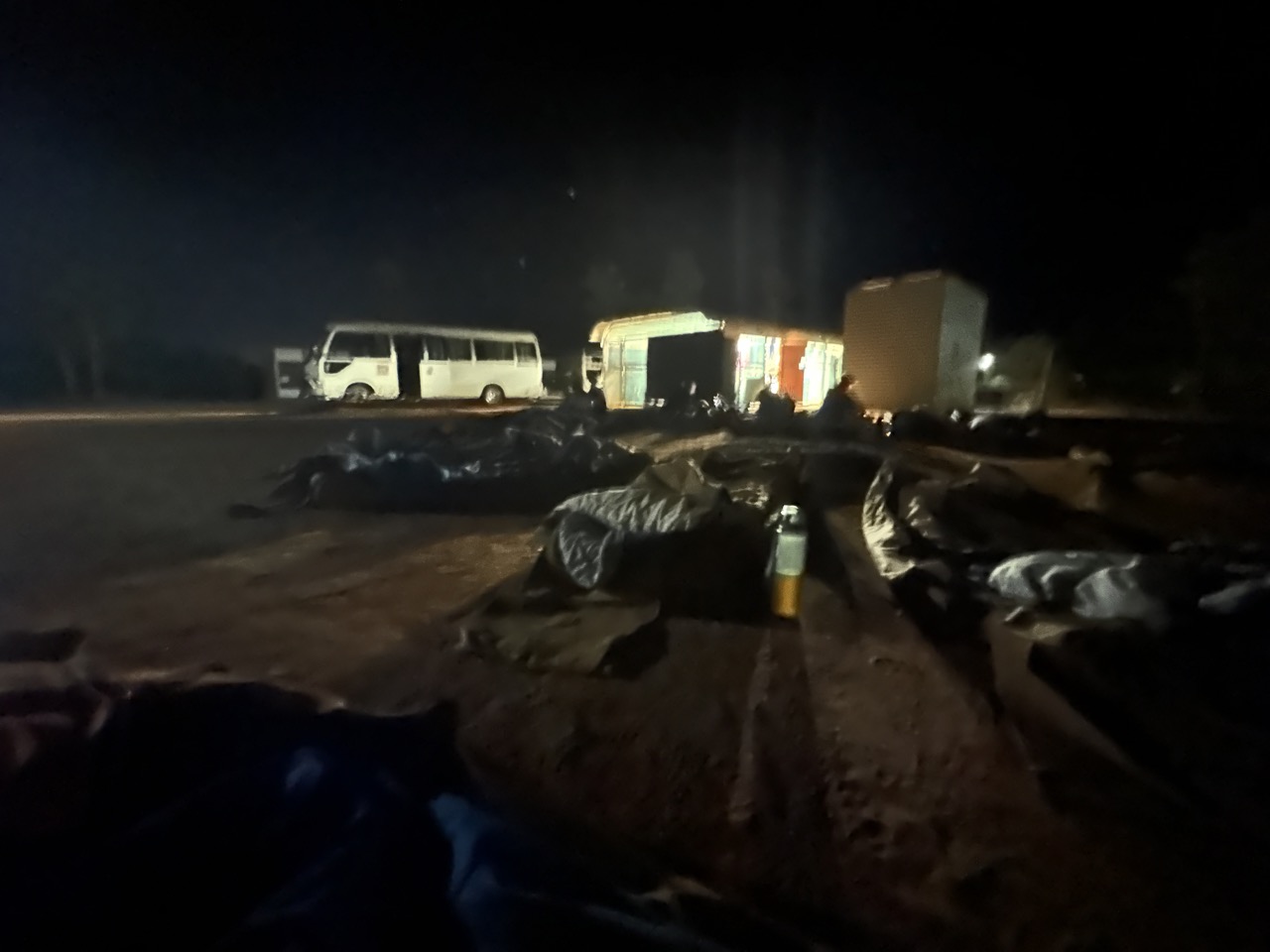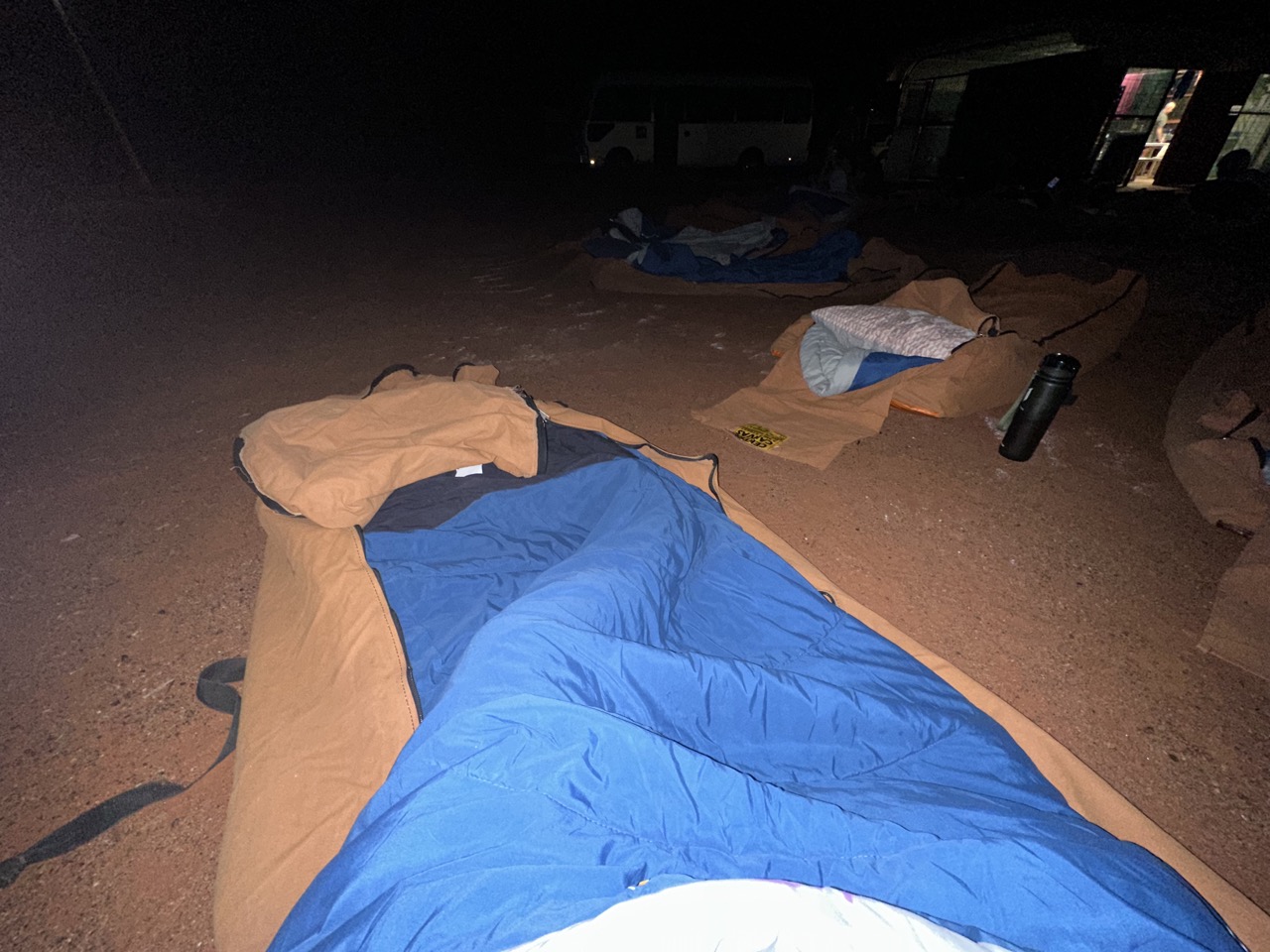Justin Applefield
Uluru
February 10, 2023
I woke up nice and early because I had booked a 4 day, 3 night trip to the Outback through Mulga's Adventures, and the pickup was at my hostel at 6am. I got up to pack my things around 5:15am. Two of the girls in my dorm room were also going on the tour, so they made lots of noise at the same time as me and it was easy to wake up. I went to the hostel kitchen to eat a blueberry muffin and iced coffee that I had purchased the previous day. A few minutes before 6 I noticed that a bus was waiting outside the gate, so I headed out. Adam, our tour guide for the next few days, introduced himself. I put my bags in the trailer attached to the back of the minibus, and hopped on board. In total we had 8 people, including Adam, in the bus as we headed out of Alice Springs towards Uluru / Ayers Rock National Park, and we would pick up the rest of our group at the Ayers Rock Airport.
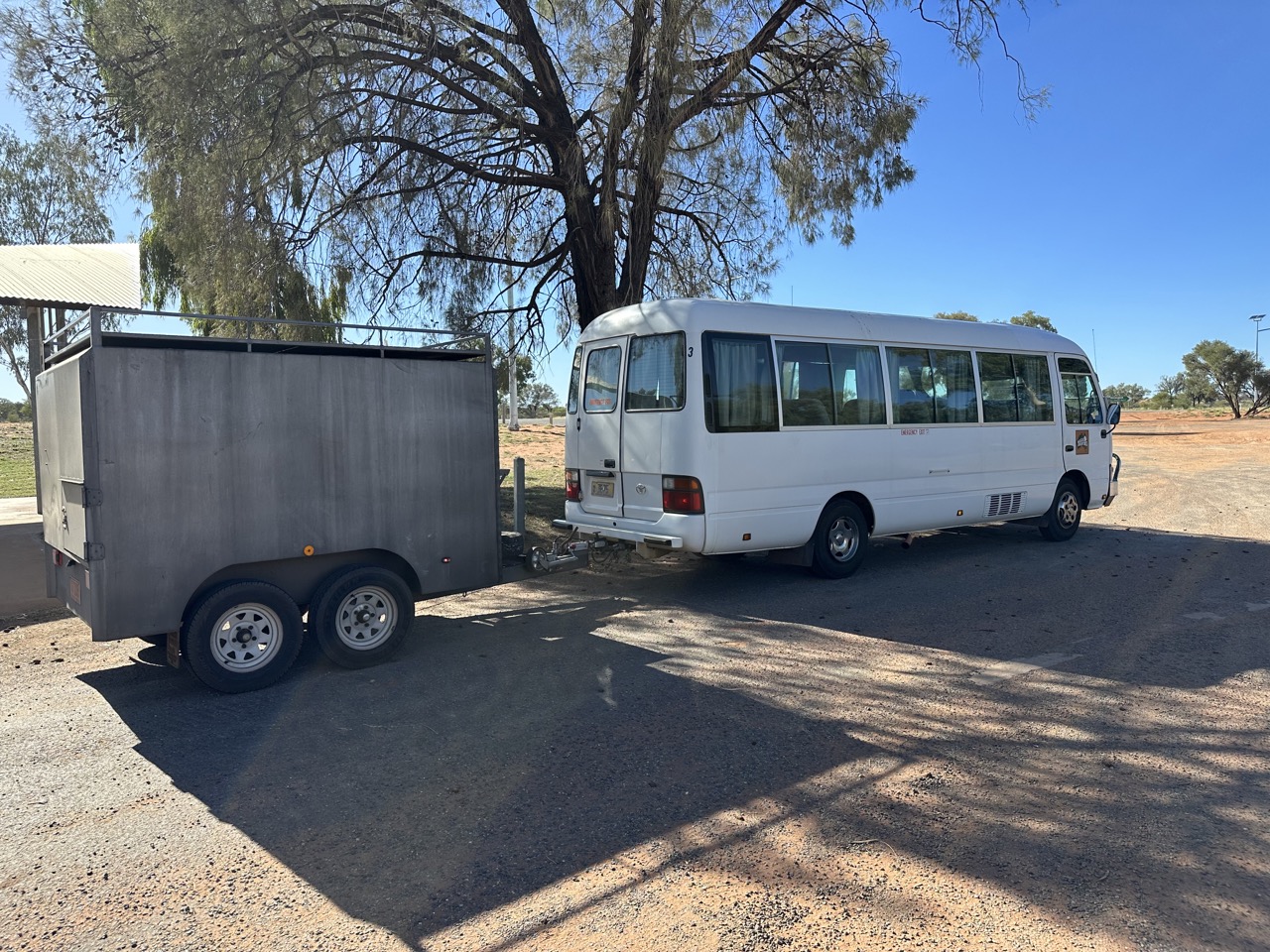
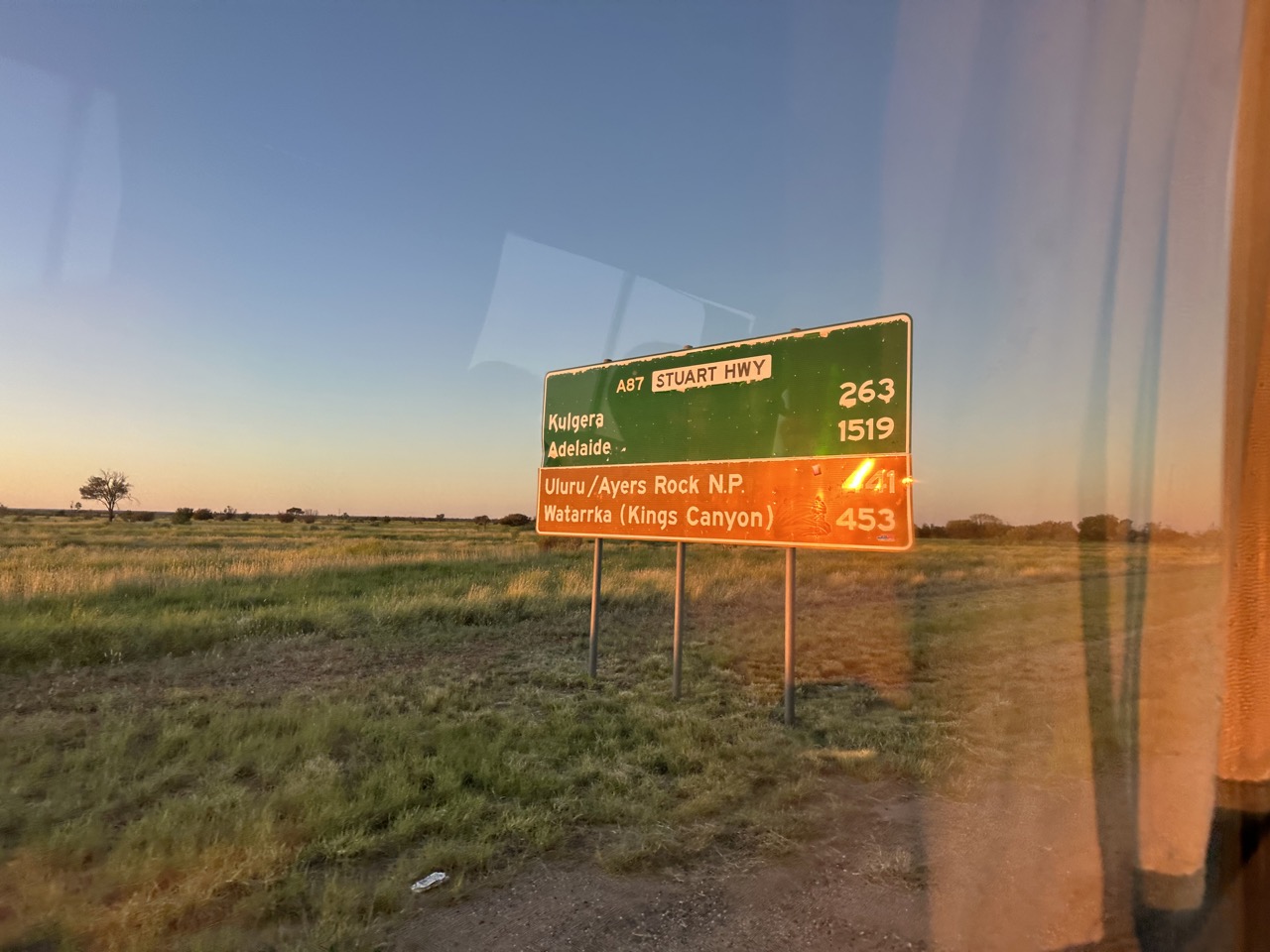
It was a long drive, about 4.5 hours, and we made stops every hour or so to use the bathroom and buy snacks. Like other tour buses, there was a microphone so Adam could narrate the journey, but he told us up front there would not be much commentary since it was so early and he would let us sleep on the bus. We would be driving through three different countries on the way to Uluru (the indigenous people refer to the land that their people controls as a country, and there are hundreds of countries in Australia). Our first was at Stuart's Well about an hour after leaving Alice Springs. I bought a flat white and used the toilet. There were a few things to look at like a big camel statue, a cockatoo, and a big snake. Then about an hour later we stopped at Erldunda Roadhouse, which claims to be located at the Center of the Center of Australia, because it is roughly in the middle between various other places you could consider to be the center of Australia (like the center of gravity, the median, the furthest point from the seat, etc.). They had some emus to look at, but I started getting harassed by bush flies as I went to look at them (being harassed by bush flies would be a theme on this trip). I wanted a snack but not much looked good so I bought a very overpriced bag of beef jerky. Then about an hour away from Uluru we stopped at Curtin Springs, where we only used the toilet, as Adam advised we would be returning there in a few days. Near Curtin Springs you could also see Atilla / Mount Conner, which the internet also refers to as "Fool-uru", because people driving from the east would see it and be fooled into thinking it is Uluru.
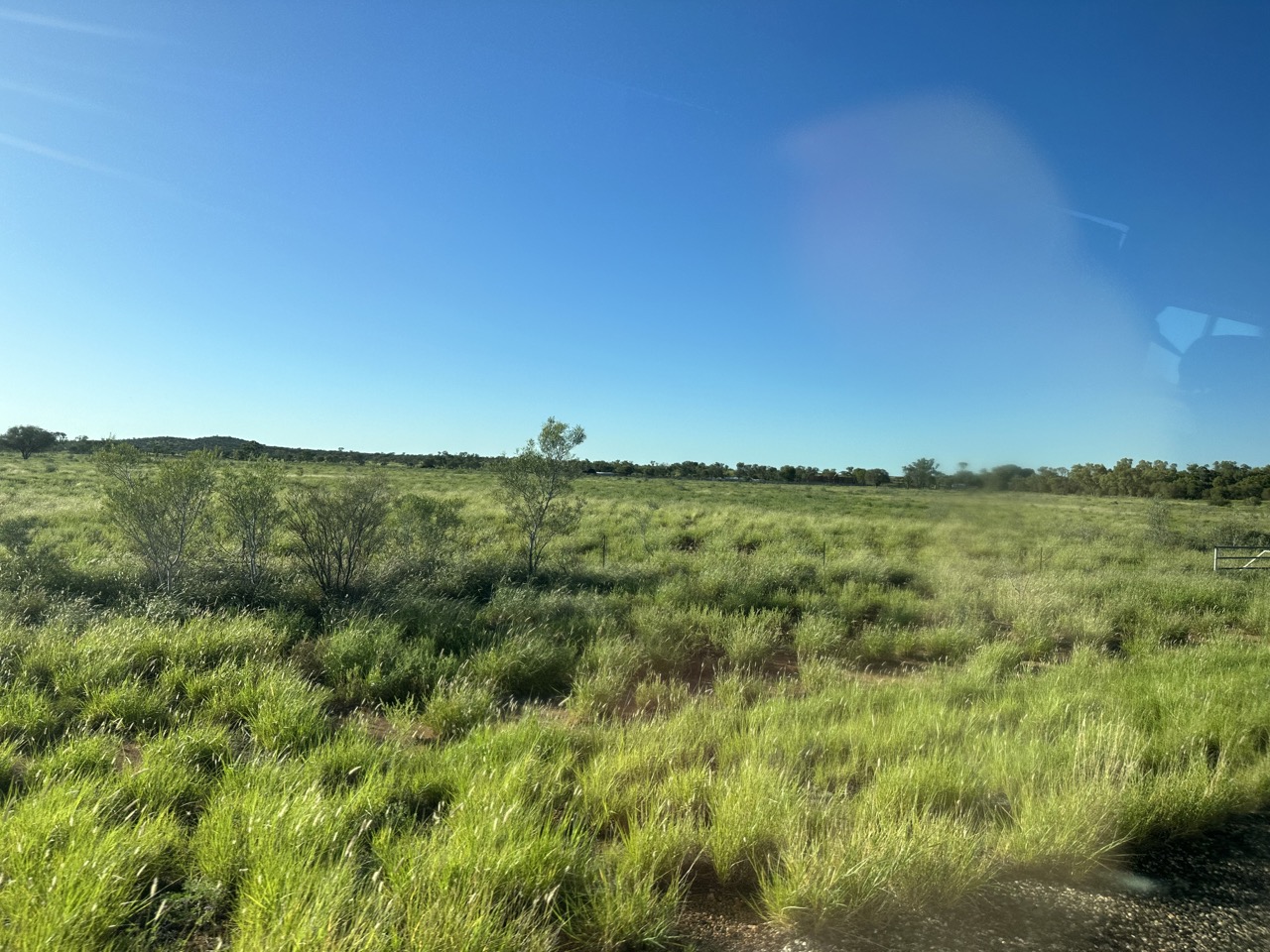
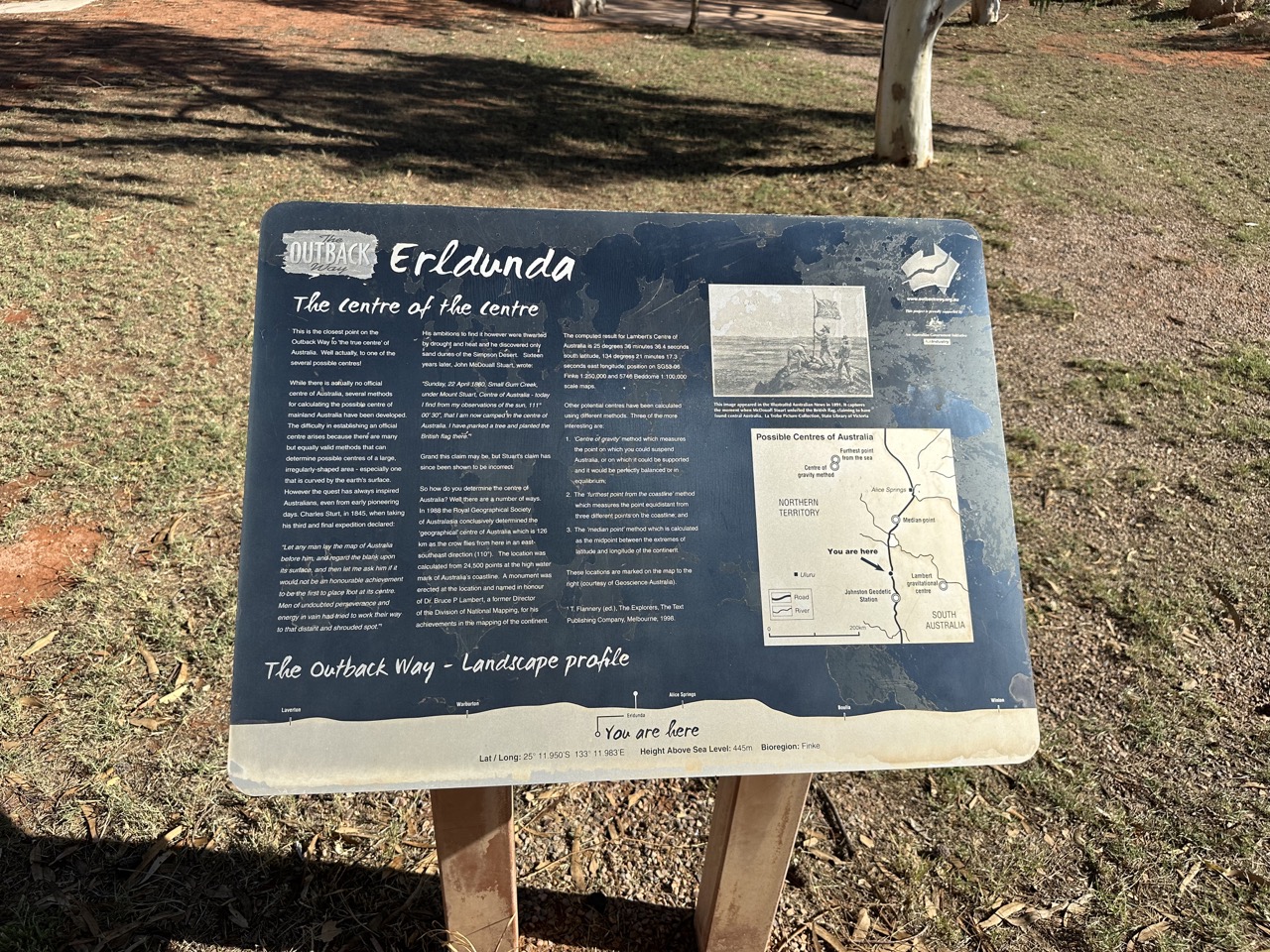
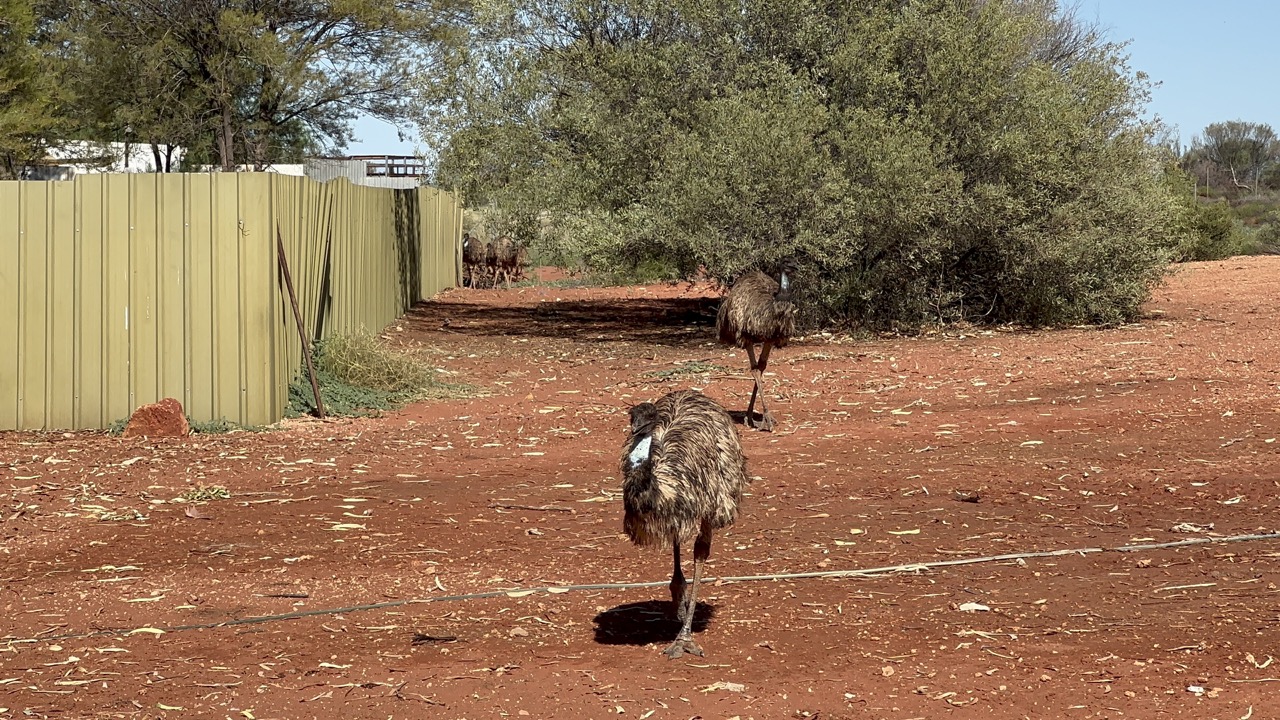
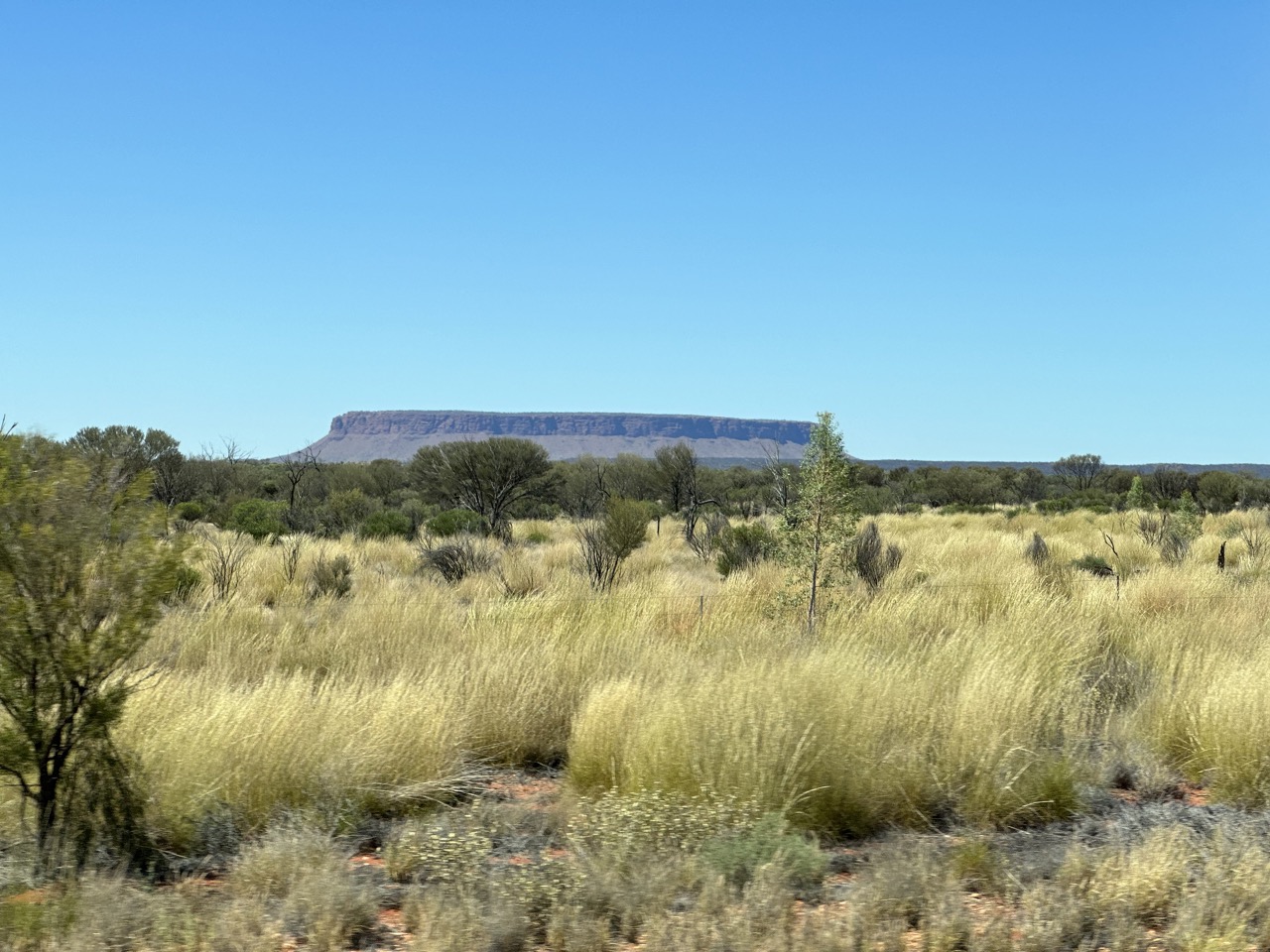
Finally around 12:15 we arrived at our campsite in the back corner of the Ayers Rock Resort. We unloaded some boxes of food from the trailer into the covered area of the campsite so that we'd have more space for people's luggage. We stopped at the gas station in the resort before heading to pick up the rest of our group from the airport. Finally, around 1pm, the entire group was assembled, except for one person, Jenna, who missed her flight and would be joining us the next day. One of the girls who came from Alice Springs, Bierte, was originally only on the bus for the ride to Yulara (the town where Ayers Rock Resort is), so she got to tag along with our tour for the day since there was an extra spot. We all introduced ourselves: there were the German girls from my hostel last night (Johanna and Luna), the Dutch girls (Roos and Inez), the Swiss Italian "crossfit" women (Meli and Pietra), the Australian couple (Marlou and Chris), the German au pair Loretta and her mother Henrietta and aunt Uti, another German woman Marie (who may have been an au pair) and her mother Gabby, a younger German couple (Elisa and Nils 1), two solo German guys (Nils 2 and Philipp), and two Japanese girls (one was Miku, the other's name I missed).
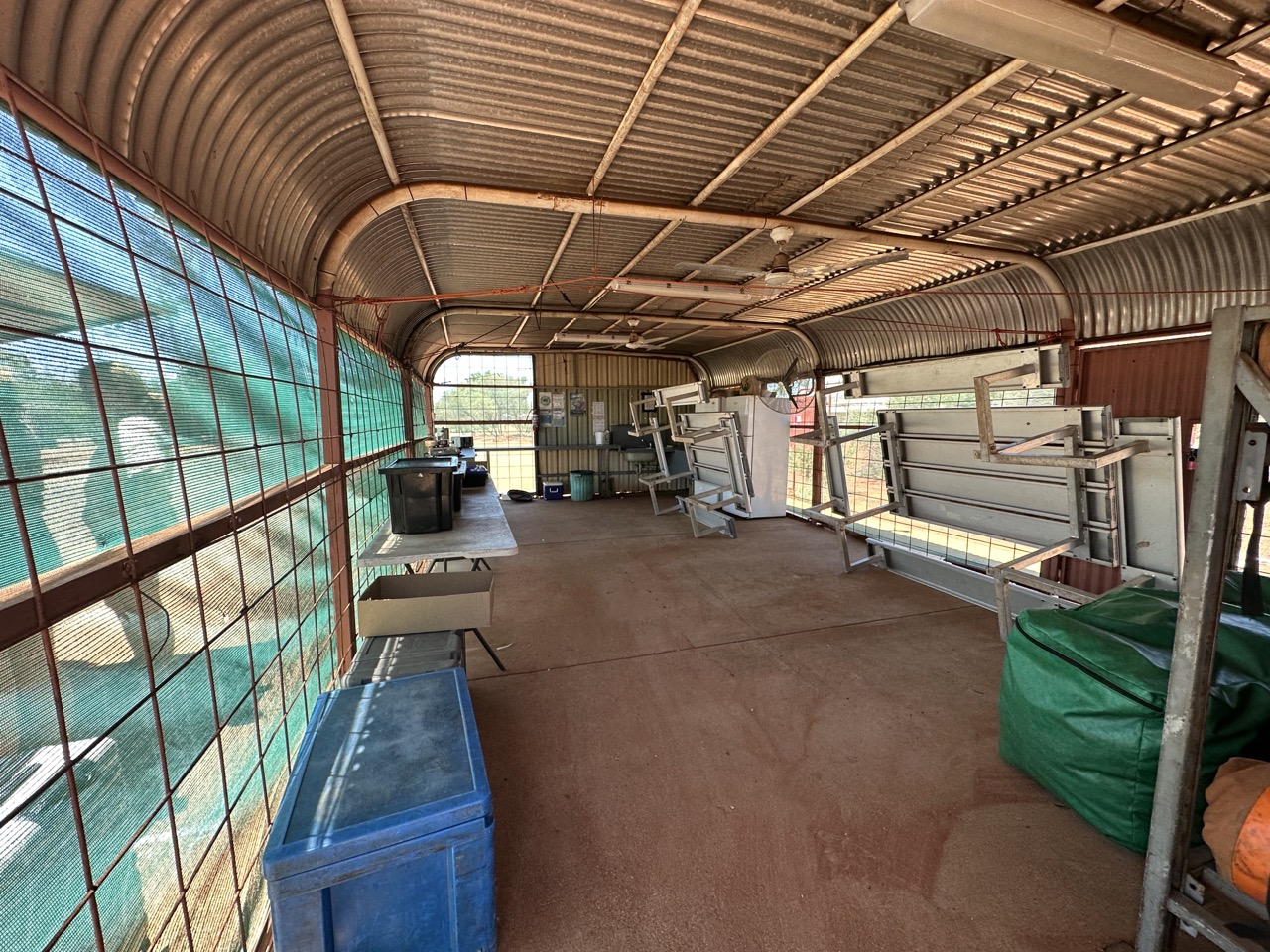
After picking everyone up we headed straight for Uluru and stopped at the "sunset spot" to take some photos. It was great because we were the only people there in the peak of the afternoon heat, so we were able to get unobstructed photos. After taking photos we headed to the Cultural Center to learn more about the significance of Uluru to the local Anangu people. They asked that no photos be taken in the cultural center. Most of the displays talked about the creation story of Uluru. Long ago, during a period referred to as "dreamtime" when the modern day Aboriginal people's ancestors (who in this case, are part-animal, for example the "mala" people are half wallaby) were roaming the land, it was completely flat and featureless, and through the course of events of their cause, the noteworthy features of the land were formed. Various features of Uluru are also explained with these Dreamtime myths, such as Kuniya the Woma Python who is surprised and killed by a group of venomous snakes wielding spears, which formed many holes in the rocks. There is a dark wavy line which is Kuniya.
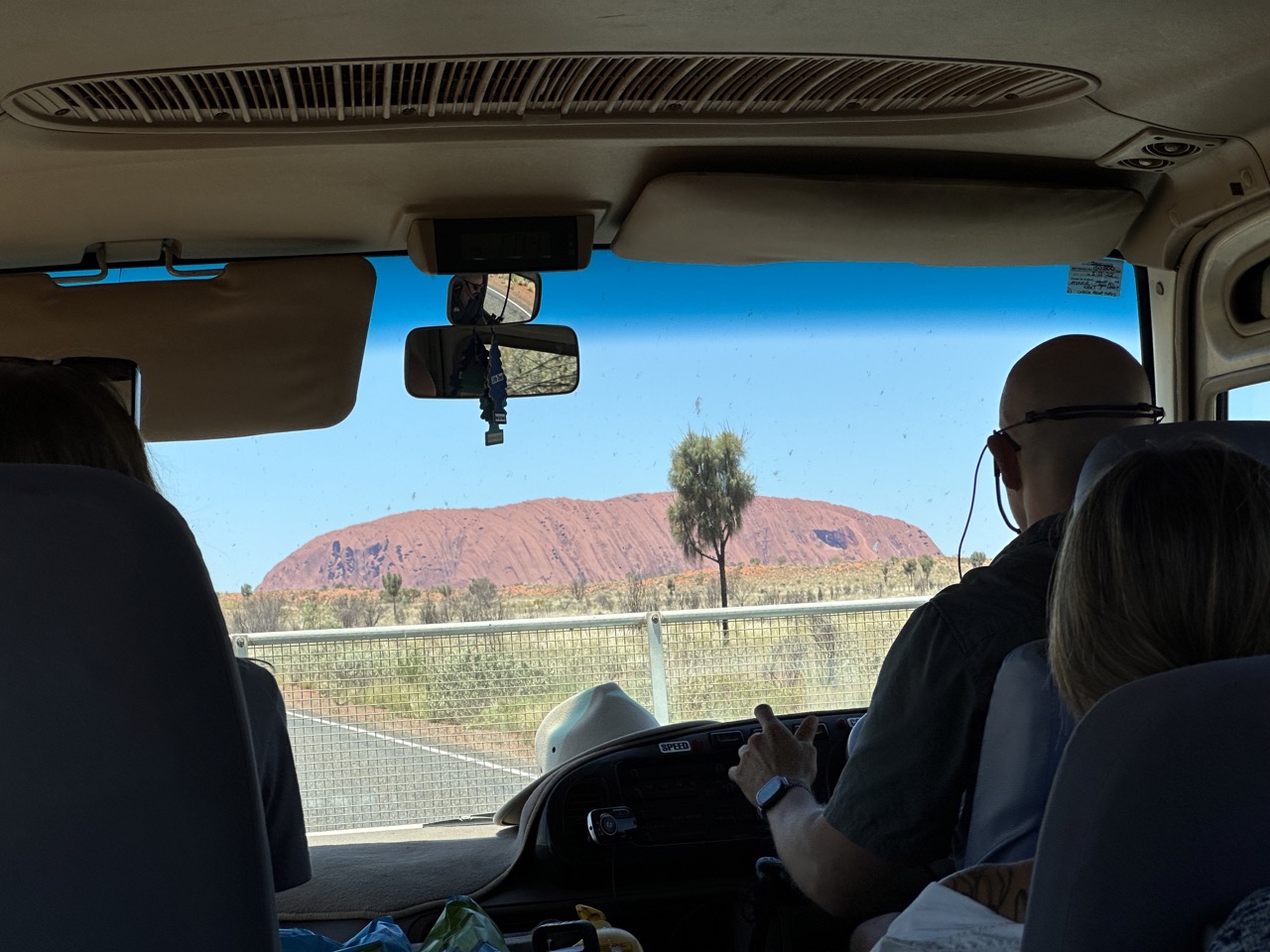
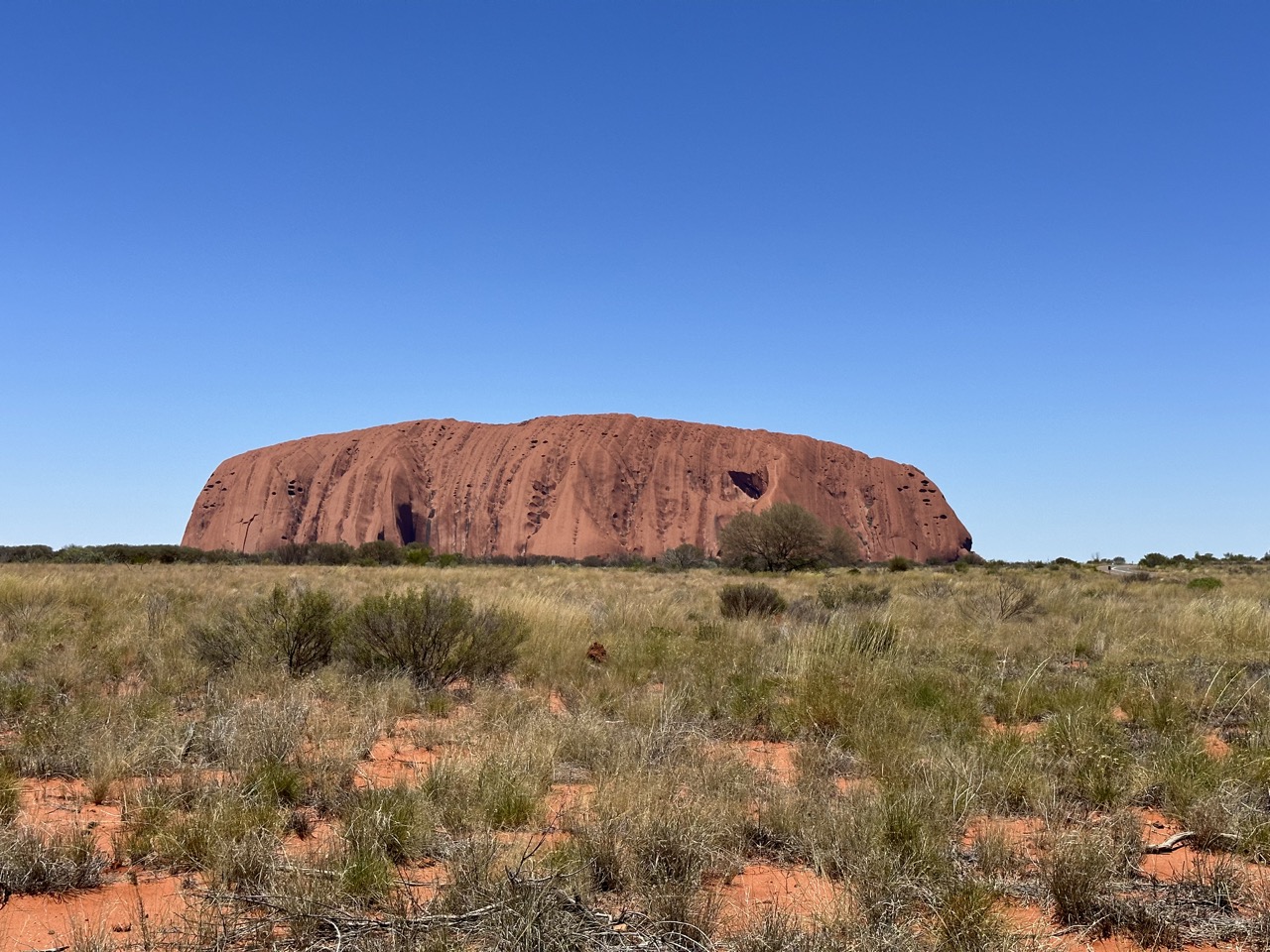
We then drove to the base of Uluru itself. There is a 10km walk around the entire rock, but the trail was closed in the afternoon because it was too hot. Adam gave me, Philipp, and Nils 1 water guns, and gave some other members of the group spray bottles, and told us to shoot each other. As we were walking, there were signs on the ground giving both mythical and scientific explanations for how some of the features may have formed. We came across a large cave where we sat for a while as Adam told us some stories that the Anangu had told him. (Adam prefers not to call them Aboriginal, he usually said Indigenous or uses the name of the people, because he says that the "ab-" prefix means not; I think this is a misconception, adn actually "ab-" means from, so "ab origine" means "from the beginning," as in these people have been here from the beginning). From the perspective of the Anangu, we would be "children," in the sense that we are not "adults" because we have not gone through the initiation ceremonies, so we only get to hear the children's stories. The story goes that Uluru was formed by two boys playing in the sand and essentially building a sandcastle. Then, one of the two boys climbed up to the top, and fell down, and as he tried to hold on to the side of Uluru his fingers created scratch marks, which explains the existence of vertical lines all around Uluru. The story also serves as a warning to children not to climb Uluru because of the danger. Adam gave another explanation of the significance of Uluru to the Anangu people. Adam had spent a lot of time with them, and so he had a perspective that perhaps other tour guides may not have. As he explained it, pre-colonization, Anangu would have lived in the area immediately surrounding Uluru, and they would have used the many areas of the rock for various purposes. For example, the cave we were sitting in was a kitchen and certain surfaces of the rock were good for grinding up seeds, or others were good for storage. Because it was for cooking, it would have been a "women's area," and there is another cave that would have been the "men's area" because it is where the men's ceremony would take place. He also explained that traditionally the Anangu would have told stories by drawing in the sand, and then after telling the story they would have danced on top of it and the drawing would be covered up by their footsteps. The songs they learned were like "passports," because people from neighboring regions in the same country know different verses of the same song, and if you marry someone from another country, you can then sing their song, and when you come across someone you sing a song that you know and they can identify what country or community you are from. Adam told another story, where a rival tribe came over to Uluru to fight, and the women all ran to the men's cave to alert them, but the men were in the middle of a ceremony and were annoyed. A few men stayed behind to fight, but they were killed in the men's cave, and this left features in the side of the rock in the cave that look like people.
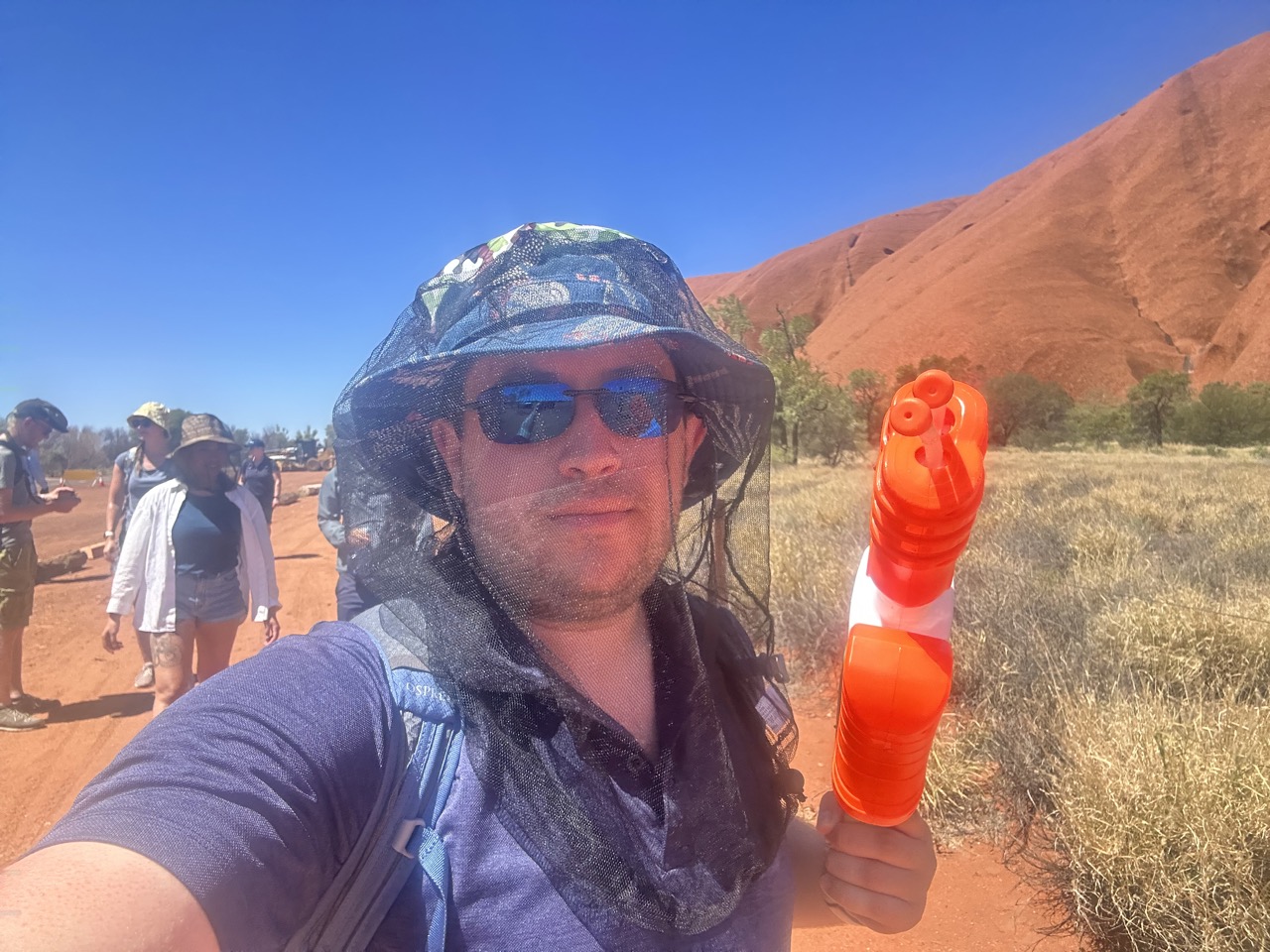
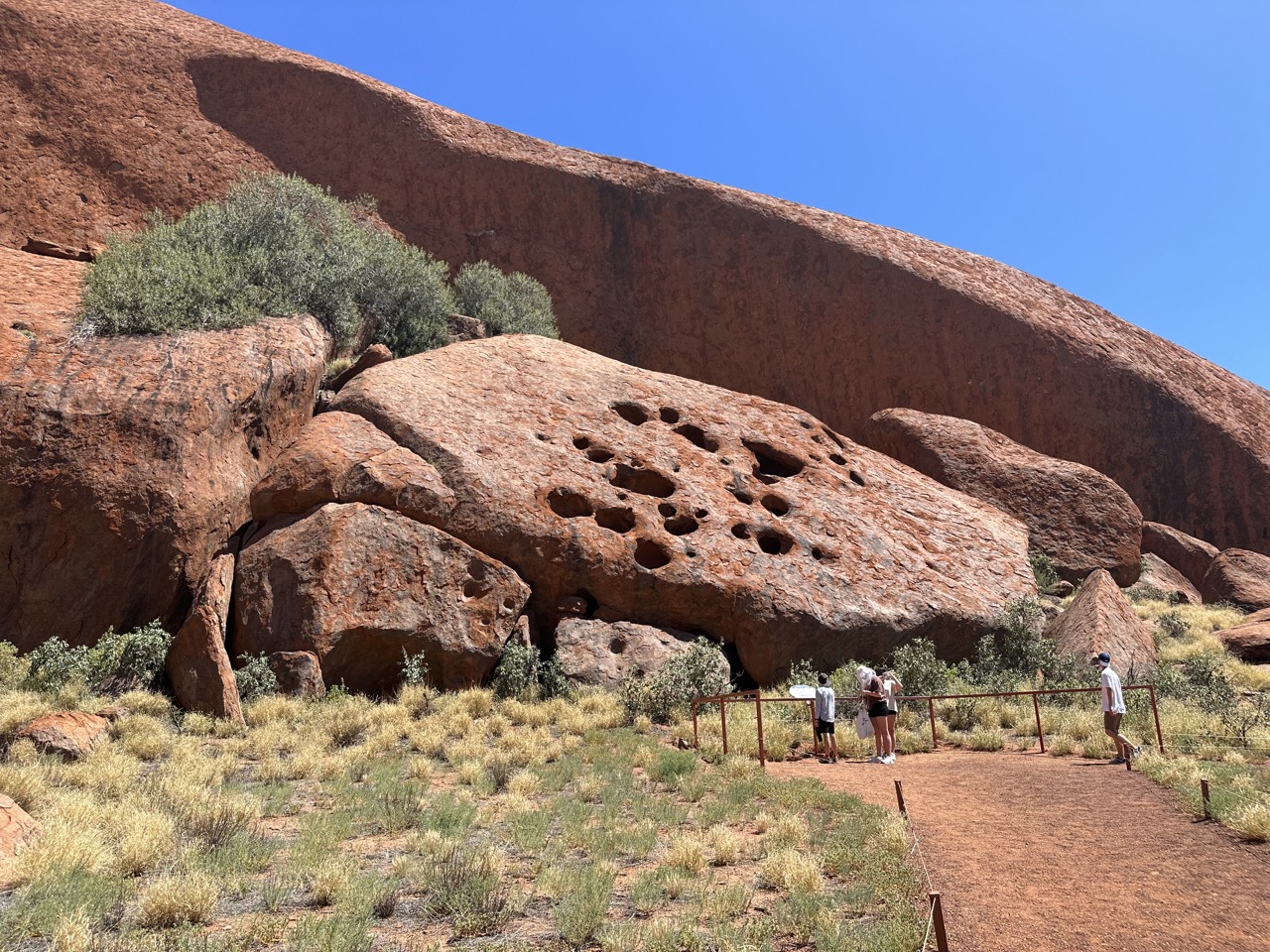
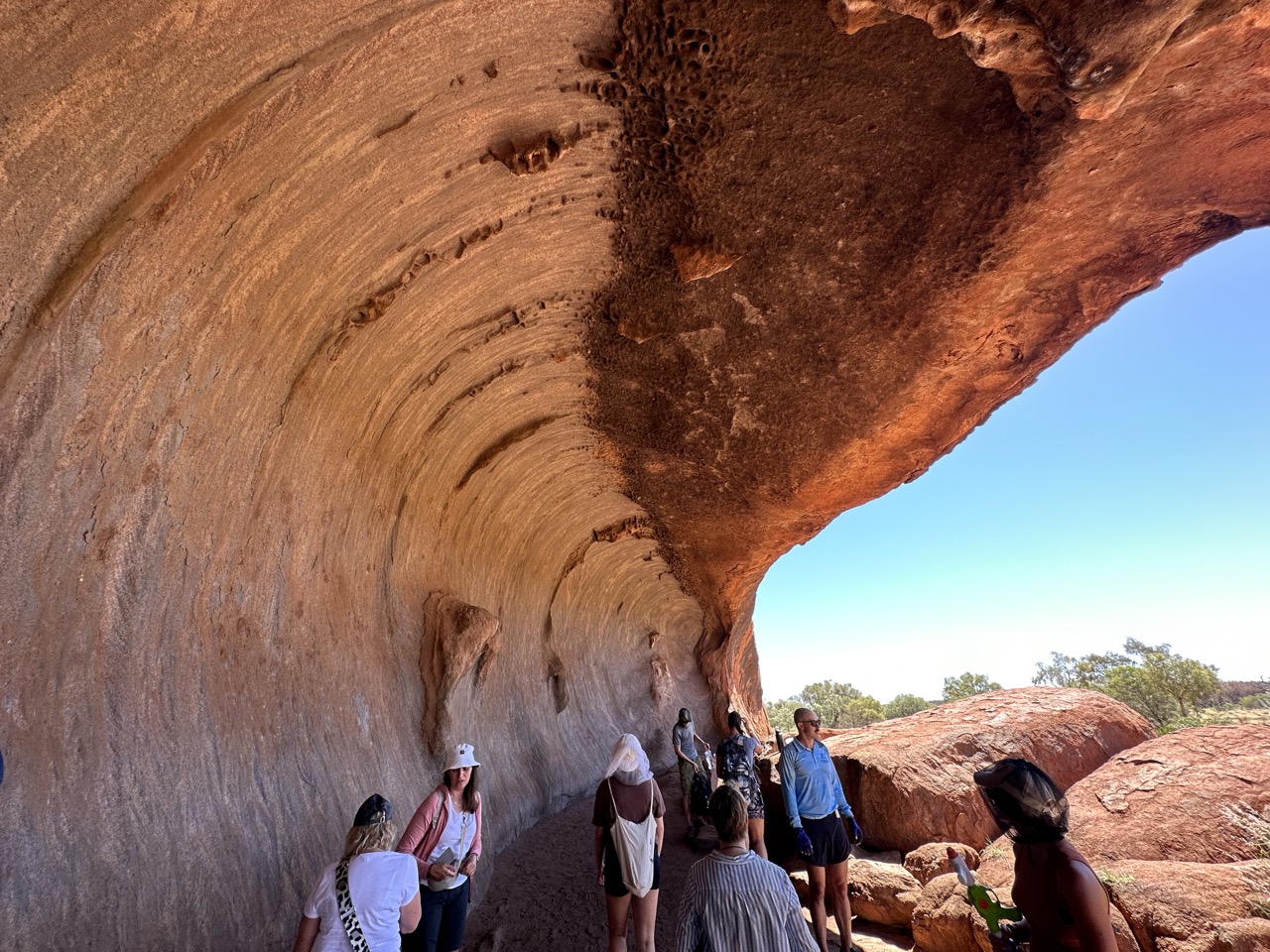
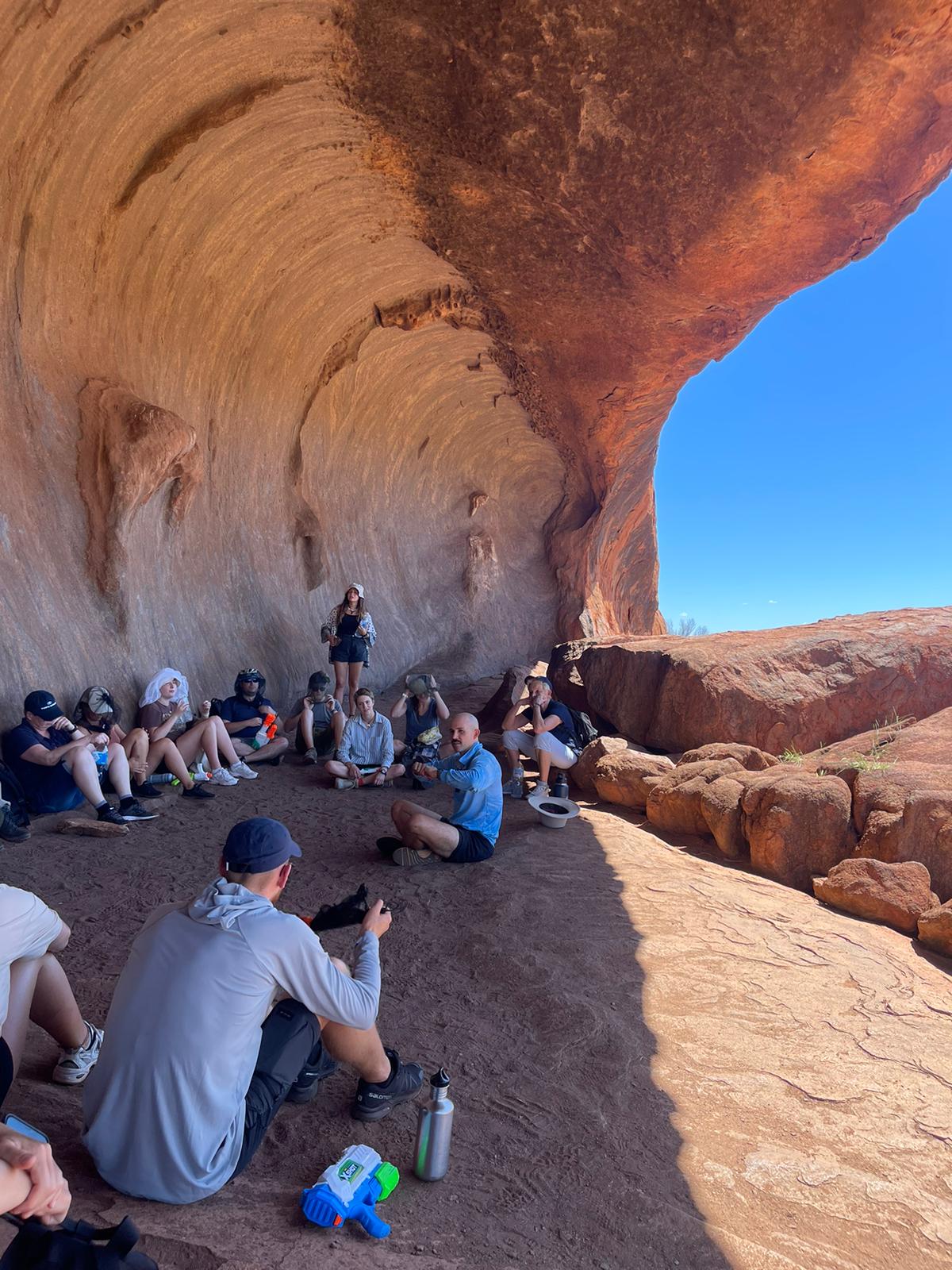
Throughout Uluru, there are some areas where photography is not permitted. Traditionally, some areas are for only men or for only women, for example, we walked past another cave called the Wallaby's pouch which was an area only for women (Adam implied, but didn't say, that this is where women would have gone to give birth). Areas that are only meant for men or for women are marked as "sensitive" and you can't take photos, because it would be disrespectful for those photos to circulate online. Likewise, some areas are for children and some are for initiated people, and so you can't take photos of the areas for initiated people because those are also sensitive. So in addition to the climb to the top being dangerous, and the Anangu feel responsibility for visitors' safety, it is also only for initiated people, so it would be disrespectful to go up.
We drove to a different section of Uluru to walk along a different section of the base. At the end of the walk was Mutitjulu Waterhole, which is a permanent water source (it has water year-round). We walked (slowly) for about 45 minutes to the waterhole and spent a few minutes there, before heading back to the bus to wait for Adam, who had gone on a run around the entirety of Uluru while we were walking (in the 100+ degree weather).
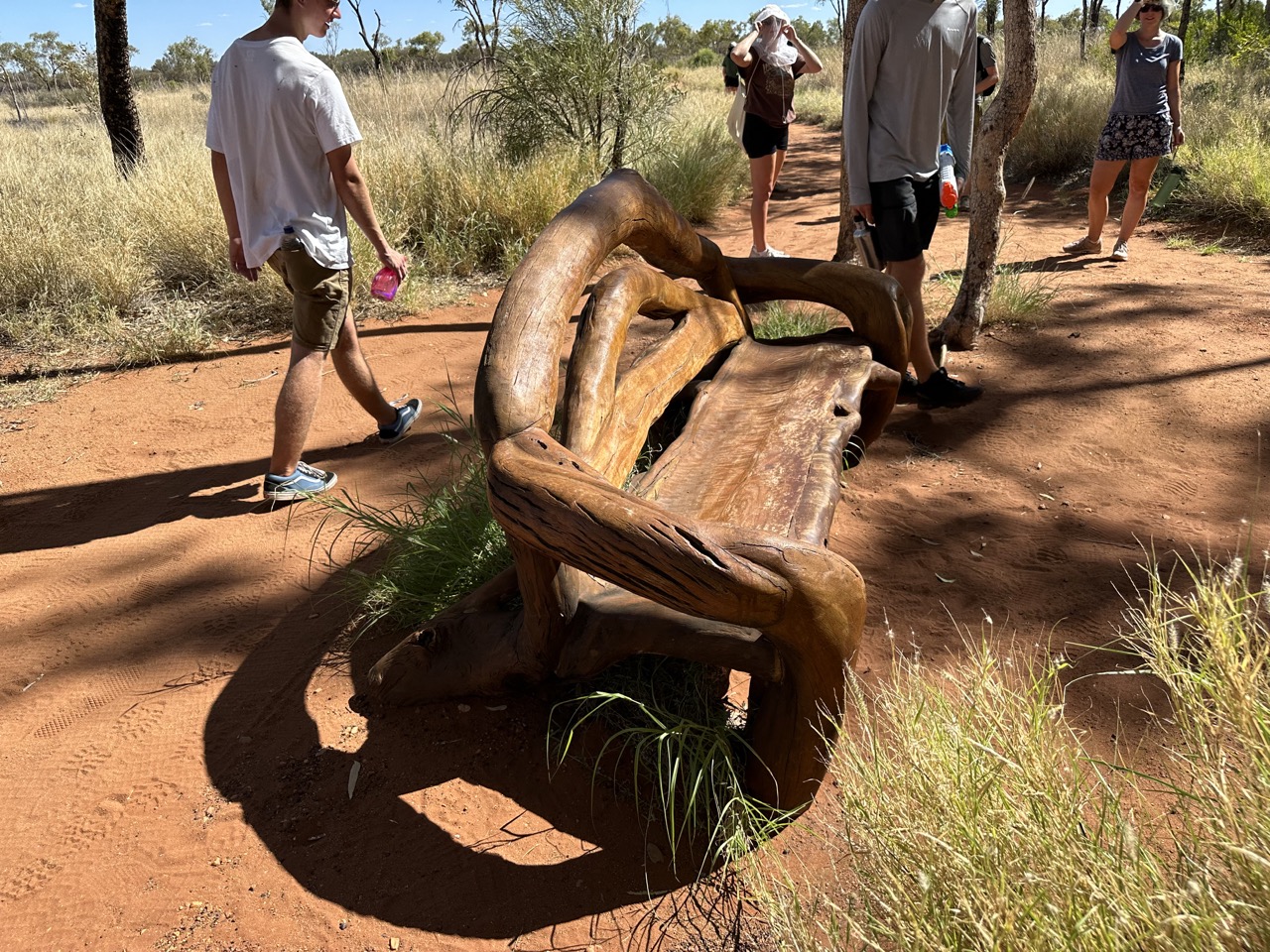
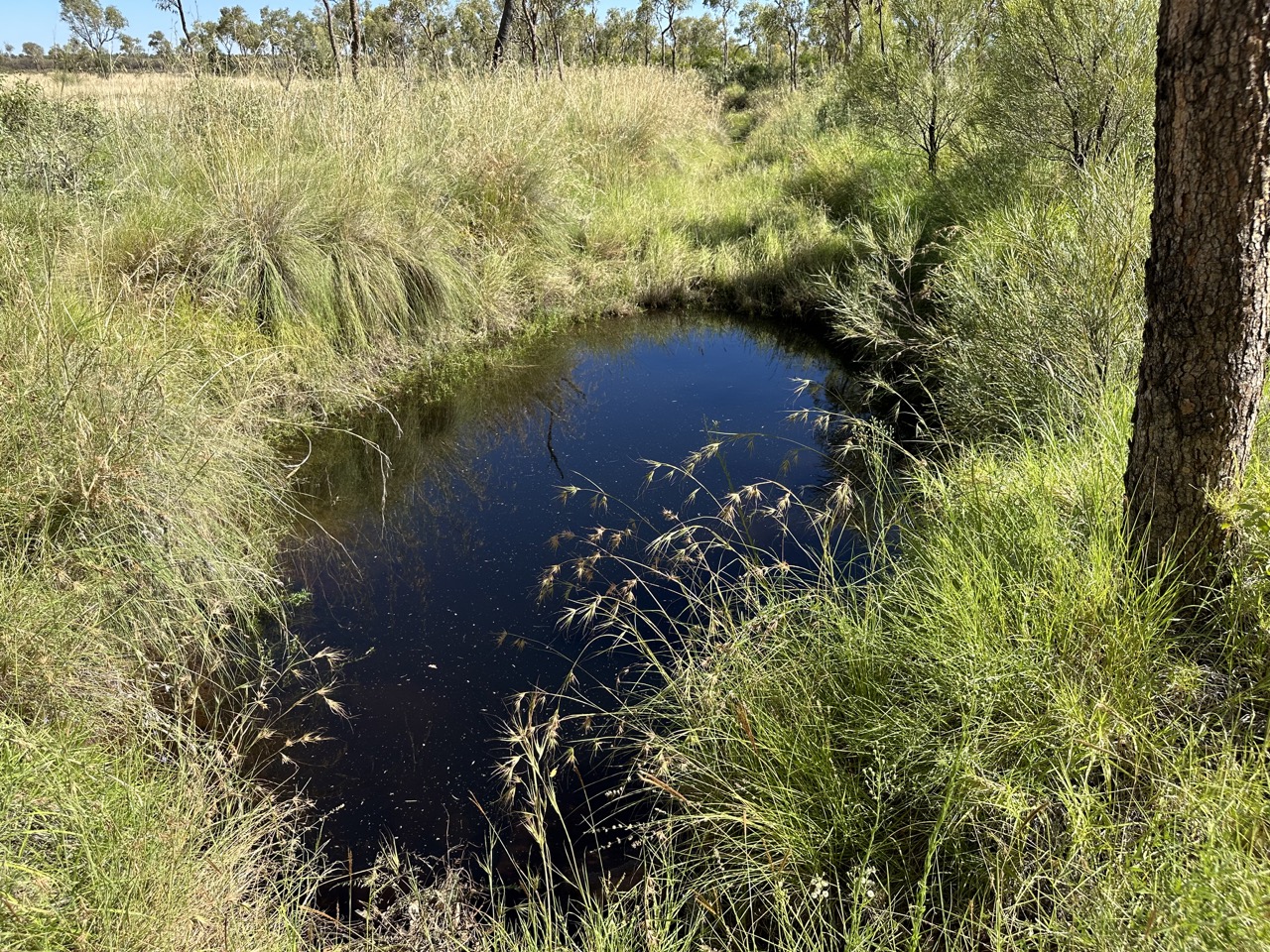
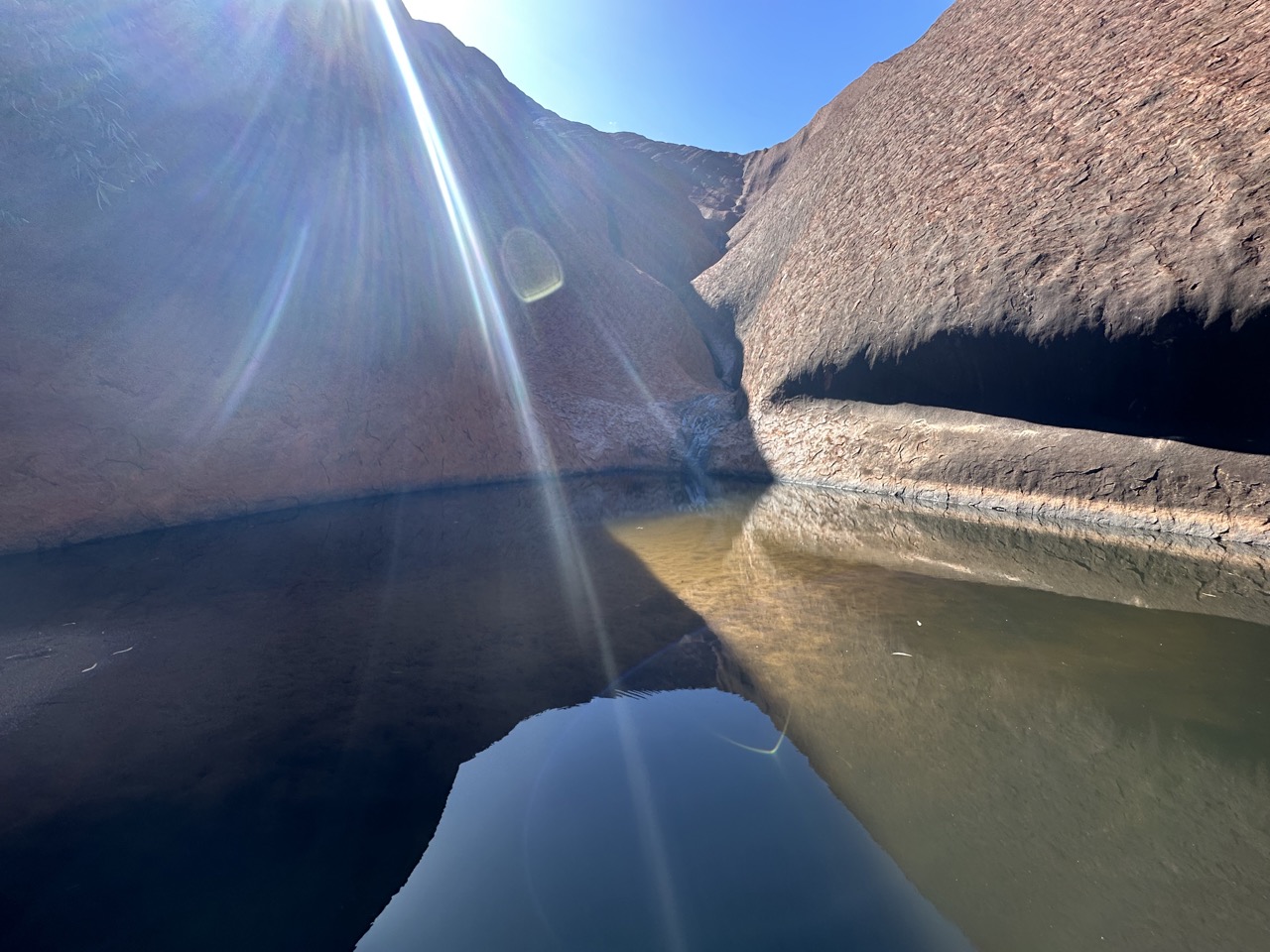
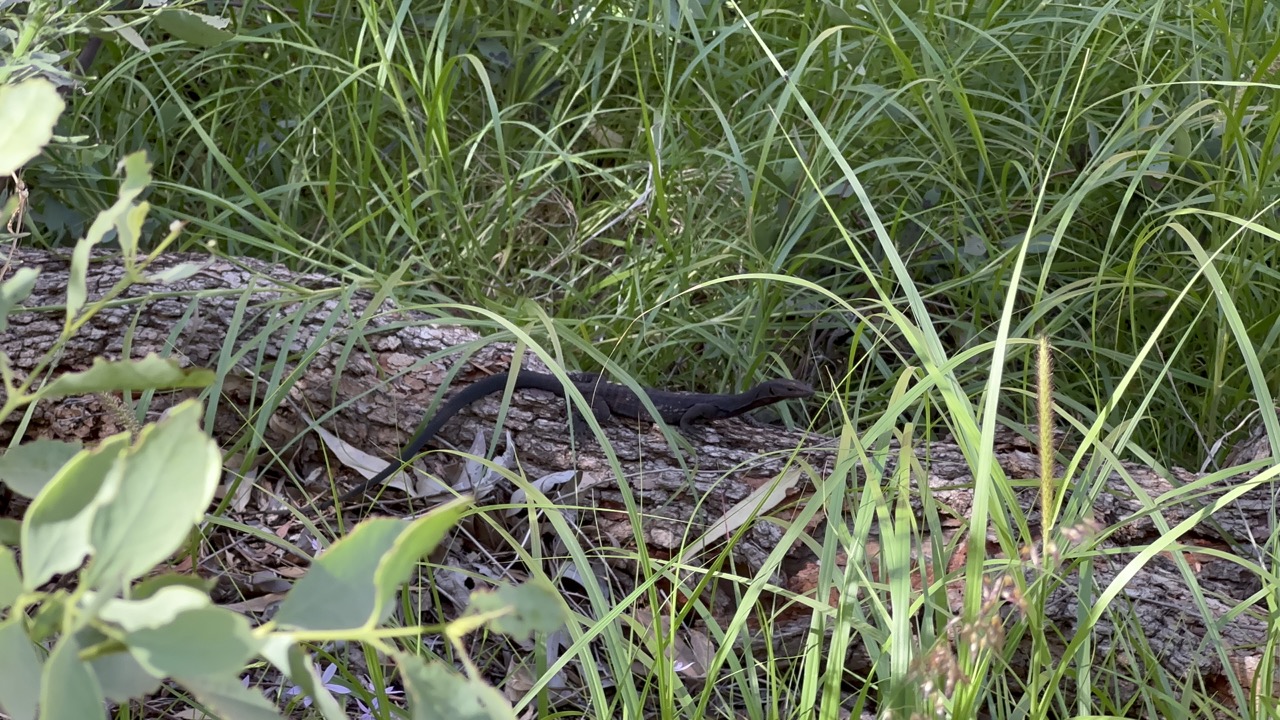
On the bus back to the campsite, Adam divided us into three "teams", Team Dingo, Team Kangaroo, and Team Snake, for cooking and cleaning responsibilities. I was on Team Kangaroo. For tonight, Team Dingo would cook dinner, and Team Kangaroo would clean. I went to the pool at the campsite to relax for a bit while they were cleaning, the water was super cold but it was refreshing since it was so hot out. Then I headed back to the campsite to eat. For dinner was beef burritos, which were pretty good, especially since I was so hungry.
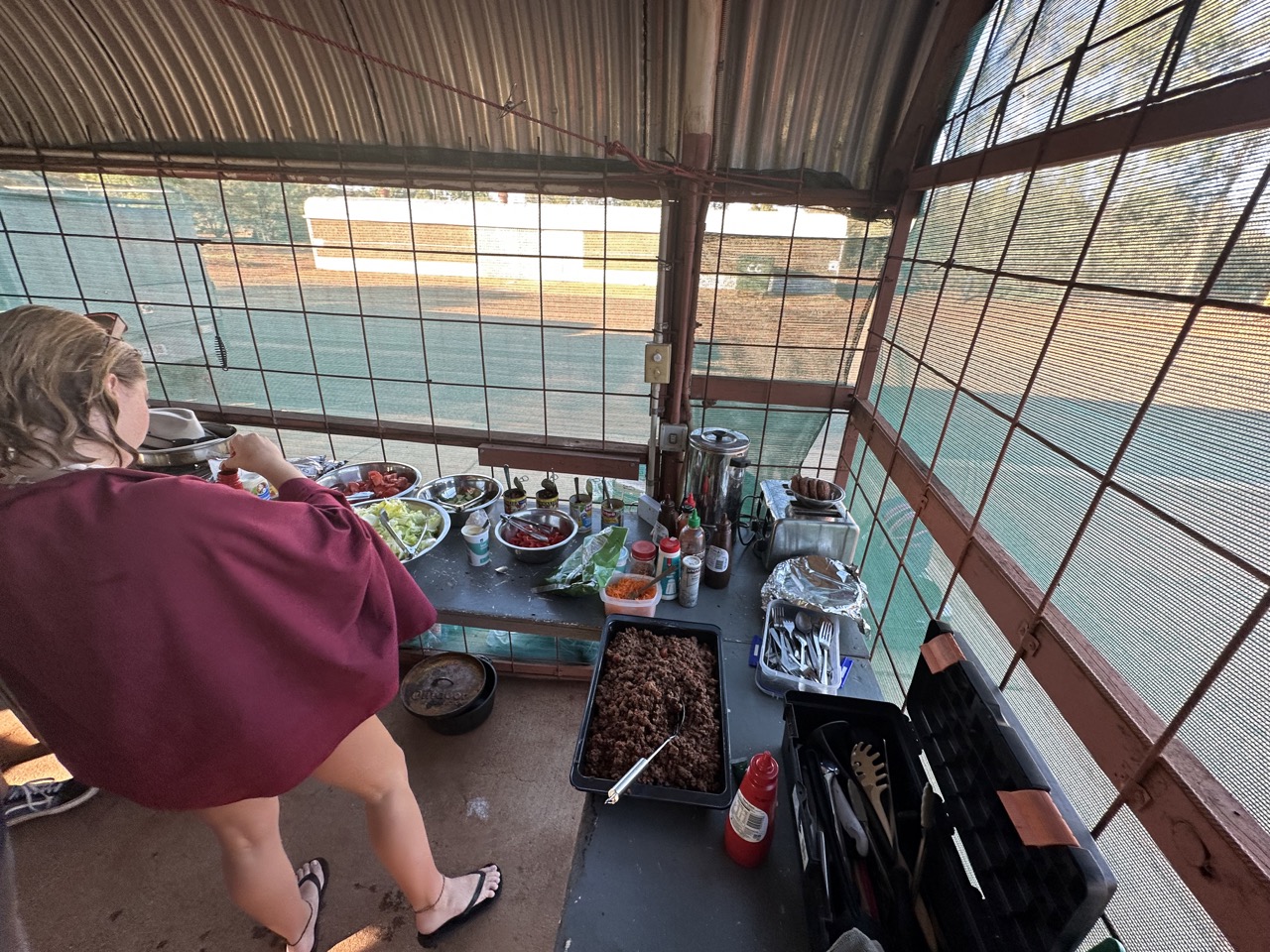
After eating we walked up a hill near the campsite to watch the sunset. The sun set behind Kata Tjuta, which is another rock part of the same national park, and the sun was illuminating Uluru as it set. We drank sparkling wine while we watched the sunset. As we sat up there, a woman named Sarah who was friends with Adam came over with her dog Yellow.
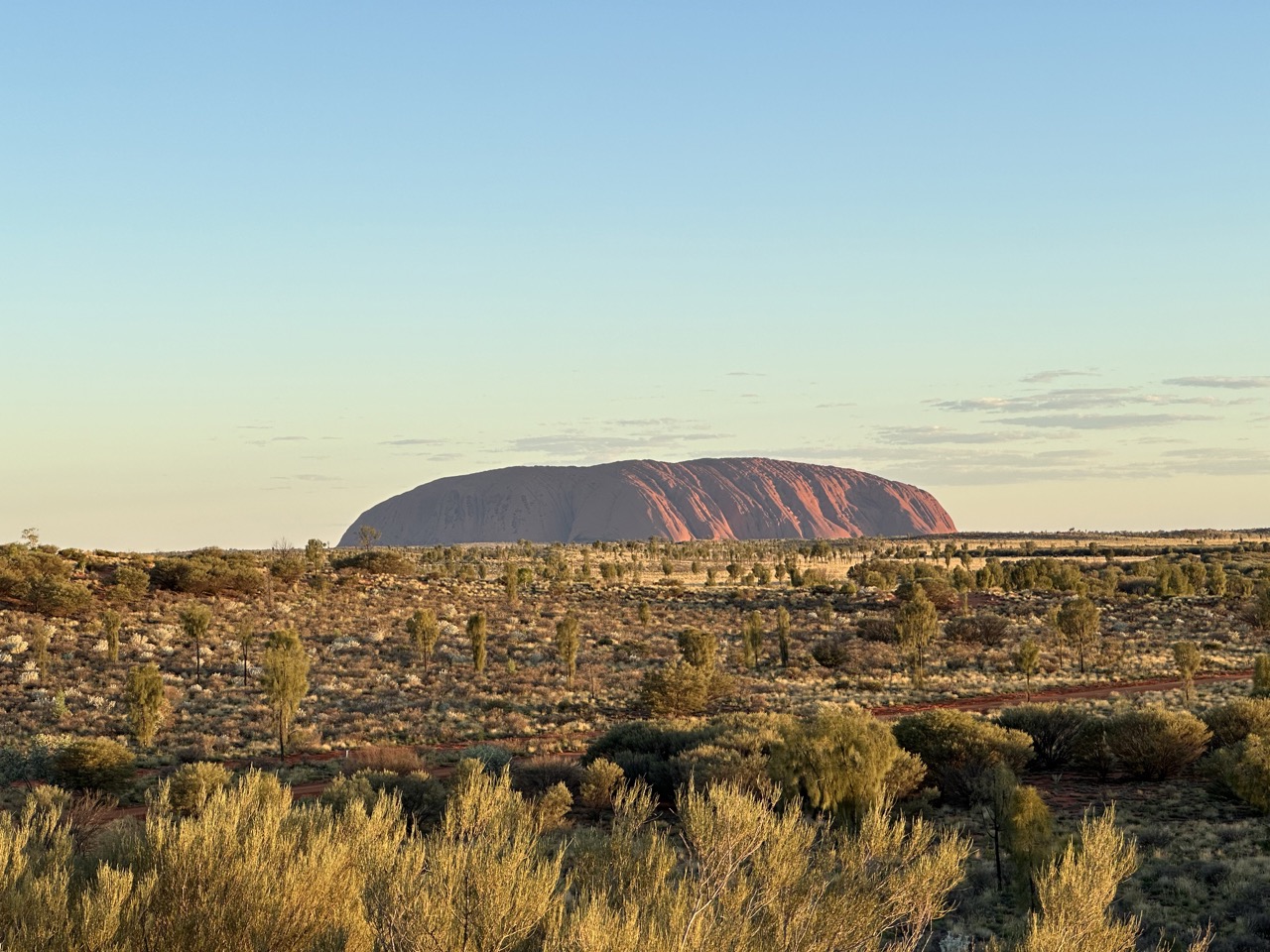
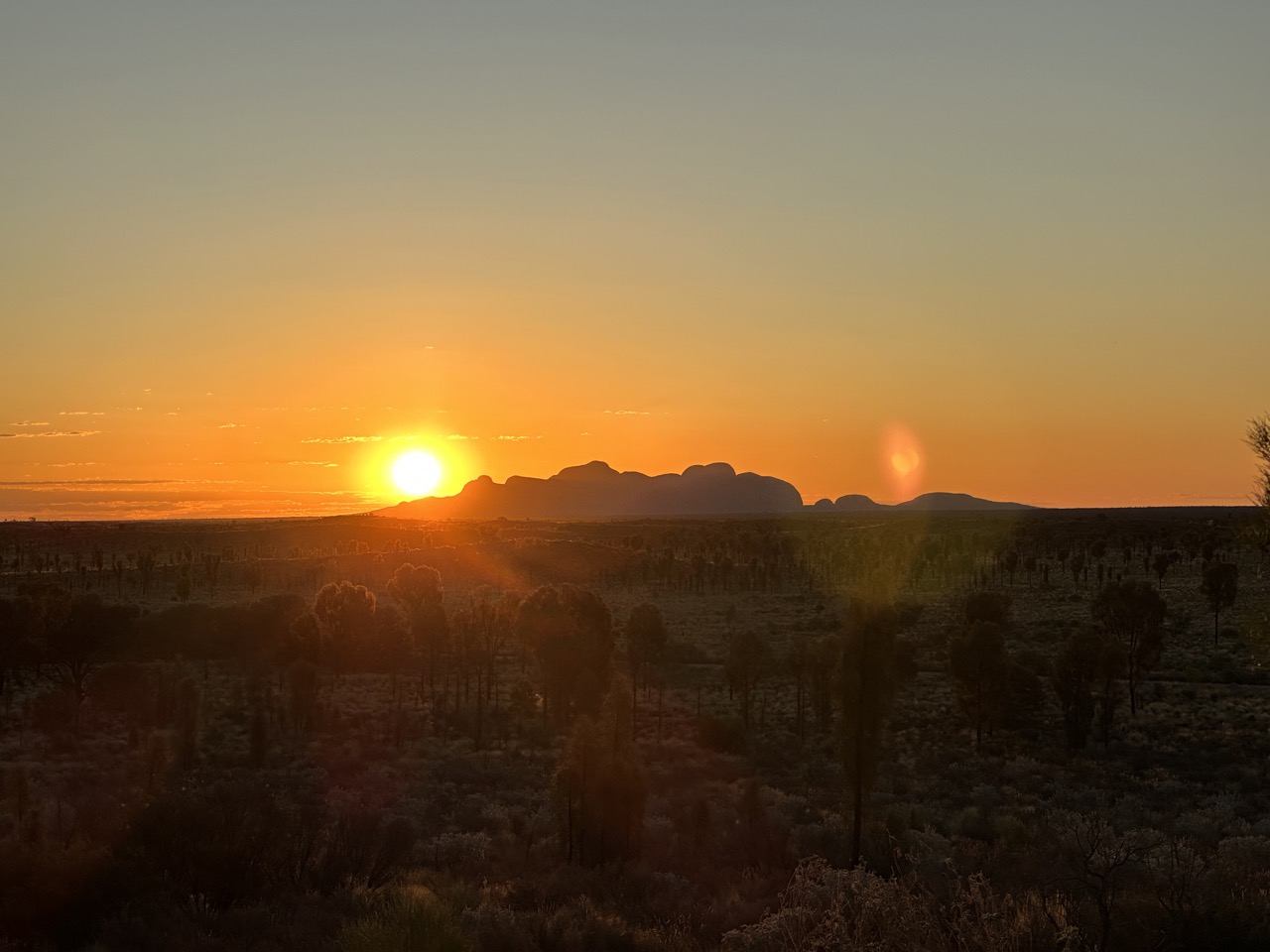
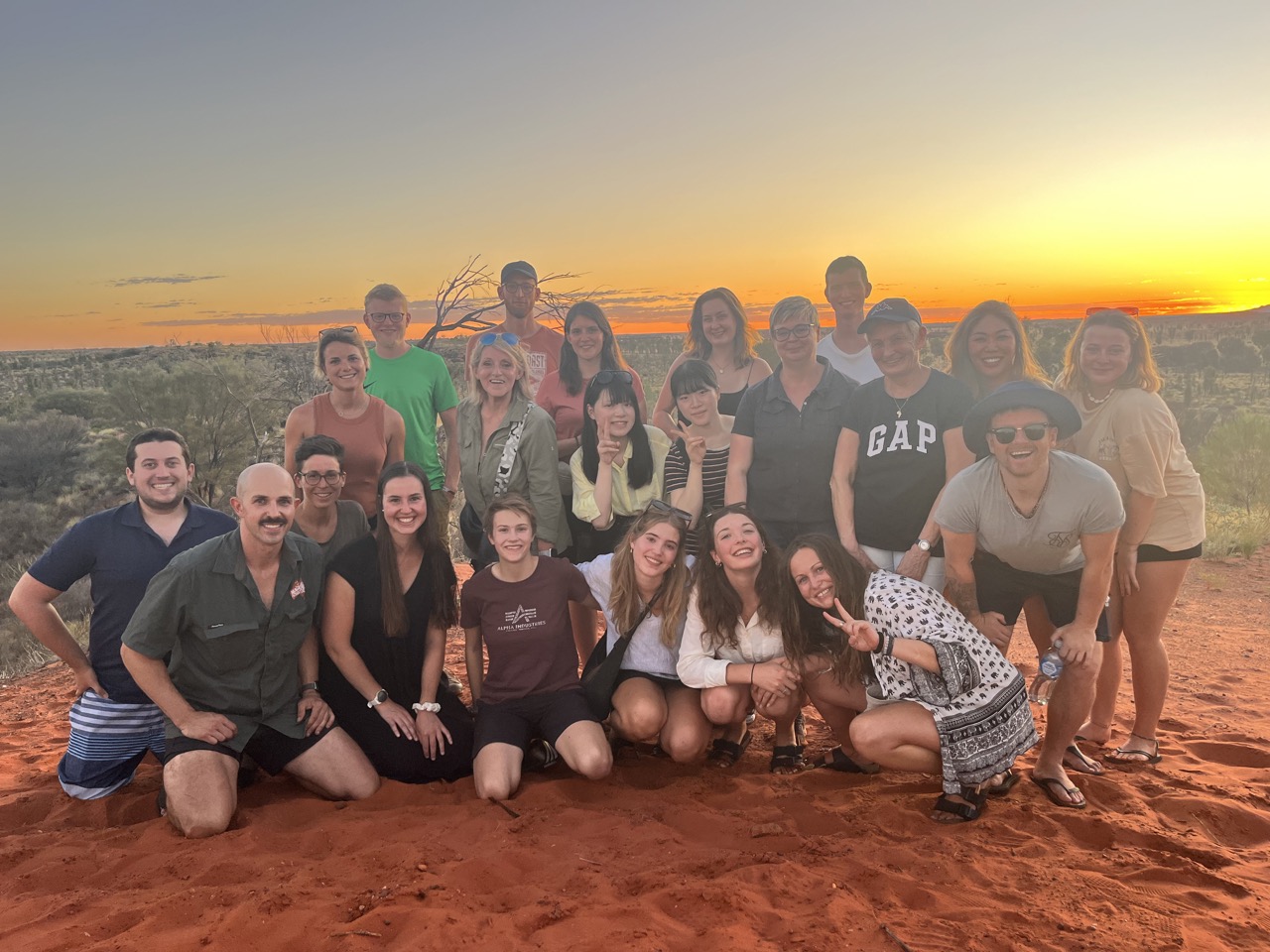
After the sunset we stayed at the top of the hill to watch the stars come out. Venus, Mars, and Jupiter (or as Adam said they were called, V-dawg, Marsie, and Jupes) were all visible, and the sky was completely clear, so once it was dark enough we could see lots of constellations perfectly clearly, like Orion, Tauros, Pleidies, and the Southern Cross. About 90 minutes after sunset we went back down to the campsite to get ready for bed. Stored in the campsite were swags, which are basically thing mattresses inside of canvas mats that can be rolled up and stored easily. According to Adam they were apparently invented by Americans in the Civil War to be carried on backpacks, but the Australians made larger ones to carry on horses and camels. There isn't really anything threatening that will attack you in your sleep, so it is safe to sleep on the swags with no covering, but we used sleeping bags to line them for sanitary purposes. Adam said that there are local children who come to steal things in the middle of the night, so we locked all our bags inside the bus or the campsite shelter. I took a shower then set up my swag on the ground near the fire pit, and went to sleep.
